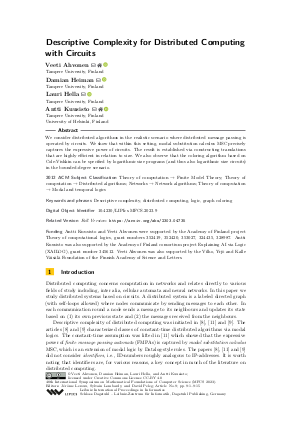Descriptive Complexity for Distributed Computing with Circuits
Authors
Veeti Ahvonen  ,
Damian Heiman
,
Damian Heiman  ,
Lauri Hella
,
Lauri Hella  ,
Antti Kuusisto
,
Antti Kuusisto 
-
Part of:
Volume:
48th International Symposium on Mathematical Foundations of Computer Science (MFCS 2023)
Part of: Series: Leibniz International Proceedings in Informatics (LIPIcs)
Part of: Conference: Mathematical Foundations of Computer Science (MFCS) - License:
 Creative Commons Attribution 4.0 International license
Creative Commons Attribution 4.0 International license
- Publication Date: 2023-08-21
File

PDF
LIPIcs.MFCS.2023.9.pdf
- Filesize: 0.74 MB
- 15 pages
Document Identifiers
Related Versions
- Full Version https://arxiv.org/abs/2303.04735
Subject Classification
ACM Subject Classification
- Theory of computation → Finite Model Theory
- Theory of computation → Distributed algorithms
- Networks → Network algorithms
- Theory of computation → Modal and temporal logics
Keywords
- Descriptive complexity
- distributed computing
- logic
- graph coloring
Metrics
- Access Statistics
-
Total Accesses (updated on a weekly basis)
0PDF Downloads0Metadata Views
Abstract
We consider distributed algorithms in the realistic scenario where distributed message passing is operated by circuits. We show that within this setting, modal substitution calculus MSC precisely captures the expressive power of circuits. The result is established via constructing translations that are highly efficient in relation to size. We also observe that the coloring algorithm based on Cole-Vishkin can be specified by logarithmic size programs (and thus also logarithmic size circuits) in the bounded-degree scenario.
Cite As Get BibTex
Veeti Ahvonen, Damian Heiman, Lauri Hella, and Antti Kuusisto. Descriptive Complexity for Distributed Computing with Circuits. In 48th International Symposium on Mathematical Foundations of Computer Science (MFCS 2023). Leibniz International Proceedings in Informatics (LIPIcs), Volume 272, pp. 9:1-9:15, Schloss Dagstuhl – Leibniz-Zentrum für Informatik (2023)
https://doi.org/10.4230/LIPIcs.MFCS.2023.9
BibTex
@InProceedings{ahvonen_et_al:LIPIcs.MFCS.2023.9,
author = {Ahvonen, Veeti and Heiman, Damian and Hella, Lauri and Kuusisto, Antti},
title = {{Descriptive Complexity for Distributed Computing with Circuits}},
booktitle = {48th International Symposium on Mathematical Foundations of Computer Science (MFCS 2023)},
pages = {9:1--9:15},
series = {Leibniz International Proceedings in Informatics (LIPIcs)},
ISBN = {978-3-95977-292-1},
ISSN = {1868-8969},
year = {2023},
volume = {272},
editor = {Leroux, J\'{e}r\^{o}me and Lombardy, Sylvain and Peleg, David},
publisher = {Schloss Dagstuhl -- Leibniz-Zentrum f{\"u}r Informatik},
address = {Dagstuhl, Germany},
URL = {https://drops.dagstuhl.de/entities/document/10.4230/LIPIcs.MFCS.2023.9},
URN = {urn:nbn:de:0030-drops-185433},
doi = {10.4230/LIPIcs.MFCS.2023.9},
annote = {Keywords: Descriptive complexity, distributed computing, logic, graph coloring}
}
Author Details
Funding
Antti Kuusisto and Veeti Ahvonen were supported by the Academy of Finland project Theory of computational logics, grant numbers 352419, 352420, 353027, 324435, 328987. Antti Kuusisto was also supported by the Academy of Finland consortium project Explaining AI via Logic (XAILOG), grant number 345612. Veeti Ahvonen was also supported by the Vilho, Yrjö and Kalle Väisälä Foundation of the Finnish Academy of Science and Letters.
References
- Veeti Ahvonen, Damian Heiman, Lauri Hella, and Antti Kuusisto. Descriptive complexity for distributed computing with circuits. CoRR, abs/2303.04735v1, 2023. URL: https://doi.org/10.48550/arXiv.2303.04735.
-
Pablo Barceló, Egor V. Kostylev, Mikaël Monet, Jorge Pérez, Juan L. Reutter, and Juan Pablo Silva. The logical expressiveness of graph neural networks. In 8th International Conference on Learning Representations, ICLR 2020. OpenReview.net, 2020.

-
Leonid Barenboim and Michael Elkin. Distributed graph coloring. Synthesis Lectures on Distributed Computing Theory, 11, 2013.

-
Benedikt Bollig, Patricia Bouyer, and Fabian Reiter. Identifiers in registers - Describing network algorithms with logic. CoRR, abs/1811.08197, 2018.

-
Richard Cole and Uzi Vishkin. Deterministic coin tossing with applications to optimal parallel list ranking. Information and Control, 70(1):32-53, 1986.

-
Andrew Goldberg, Serge Plotkin, and Gregory Shannon. Parallel symmetry-breaking in sparse graphs. Proceedings of the nineteenth annual ACM symposium on Theory of computing, pages 315-324, 1987.

-
Martin Grohe. The logic of graph neural networks. In 36th Annual ACM/IEEE Symposium on Logic in Computer Science, LICS 2021, pages 1-17. IEEE, 2021.

-
Lauri Hella, Matti Järvisalo, Antti Kuusisto, Juhana Laurinharju, Tuomo Lempiäinen, Kerkko Luosto, Jukka Suomela, and Jonni Virtema. Weak models of distributed computing, with connections to modal logic. In Darek Kowalski and Alessandro Panconesi, editors, ACM Symposium on Principles of Distributed Computing, PODC '12, pages 185-194. ACM, 2012.

-
Lauri Hella, Matti Järvisalo, Antti Kuusisto, Juhana Laurinharju, Tuomo Lempiäinen, Kerkko Luosto, Jukka Suomela, and Jonni Virtema. Weak models of distributed computing, with connections to modal logic. Distributed Comput., 28(1):31-53, 2015.

- Stefanie Jegelka. Theory of graph neural networks: Representation and learning. arXiv preprint, 2022. URL: https://arxiv.org/abs/2204.07697.
-
Antti Kuusisto. Modal Logic and Distributed Message Passing Automata. In Computer Science Logic 2013 (CSL 2013), volume 23 of Leibniz International Proceedings in Informatics (LIPIcs), pages 452-468, 2013.

-
Tuomo Lempiäinen. Logic and Complexity in Distributed Computing. PhD thesis, Aalto University, 2019.

-
Leonid Libkin. Elements of Finite Model Theory. Texts in Theoretical Computer Science. An EATCS Series. Springer, 2004.

- Andreas Loukas. What graph neural networks cannot learn: depth vs width. arXiv preprint, 2019. URL: https://arxiv.org/abs/1907.03199.
-
Fabian Reiter. Asynchronous distributed automata: A characterization of the modal mu-fragment. In I. Chatzigiannakis, P. Indyk, F. Kuhn, and A. Muscholl, editors, 44th International Colloquium on Automata, Languages, and Programming, ICALP 2017, volume 80 of LIPIcs, pages 100:1-100:14. Schloss Dagstuhl - Leibniz-Zentrum für Informatik, 2017.

-
Fabian Reiter. Distributed Automata and Logic. (Automates Distribués et Logique). PhD thesis, Sorbonne Paris Cité, France, 2017.

-
Ryoma Sato, Makoto Yamada, and Hisashi Kashima. Random features strengthen graph neural networks. In Proceedings of the 2021 SIAM International Conference on Data Mining (SDM), pages 333-341. SIAM, 2021.

